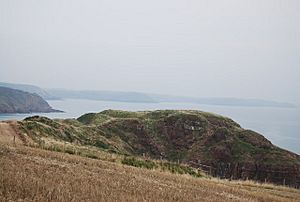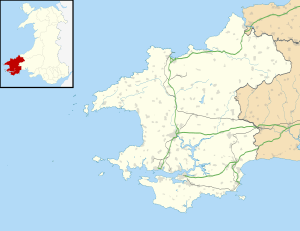Greenala Point facts for kids
Quick facts for kids Greenala Point |
|
|---|---|

The fort, viewed from the west with the Pembrokeshire Coast Path in the foreground
|
|
| Location | near Pembroke |
| OS grid | SS 006 966 |
| Coordinates | 51°37′57″N 4°52′54″W / 51.63250°N 4.88167°W |
| Area | 1.8 hectares (4.4 acres) |
| Operator | National Trust |
| Designation | Scheduled monument |
Greenala Point is a piece of land that sticks out into the sea, also known as a headland. You can find it on the south coast of Pembrokeshire, Wales. It's about a 5-kilometer (3-mile) walk south from the town of Pembroke.
This special area used to be part of the Stackpole Estate. In 1976, the National Trust took over its care. The Pembrokeshire Coast Path, a popular walking trail, goes right through the western part of the fort at Greenala Point.
Exploring Greenala Point Fort
Greenala Point is home to an ancient fort from the Iron Age. This type of fort is called a promontory fort because it's built on a headland, using the natural cliffs for protection. It is known as Greenala Point Fort or Greenala Camp. Today, it is a scheduled monument, which means it's a very important historical site protected by law.
How the Fort Was Protected
The fort covers about 1.8 hectares (4.4 acres) of land. On its east and south sides, it was naturally defended by tall sandstone cliffs. To the north, there was a steep slope with terraces, making it hard for enemies to climb. The innermost terrace was almost 5 meters (16 feet) high!
The main part of the fort, about 0.4 hectares (1 acre) in size, had strong defenses on its western side. There was a straight bank that was nearly 4 meters (13 feet) tall on the outside. Beyond this, there were three more banks and ditches, forming a series of protective walls. The Pembrokeshire Coast Path now runs through these western defenses.
Changes Over Time
Over many years, the coastline here has changed due to coastal erosion. This means the fort was once even bigger than it is today. You can still see hints of old defenses on some of the nearby sea stacks, which are tall columns of rock separated from the main land.


